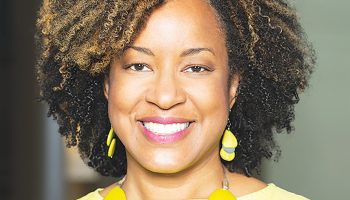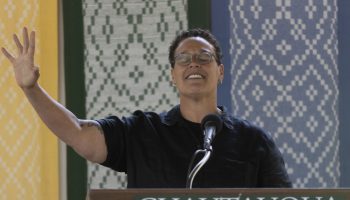
When Jennifer Eberhardt’s son was 5 years old, he and his mother sat side by side on an airplane. With an eager and observant eye for his in-flight surroundings, her son pointed out a passenger, saying “that guy looks like daddy,” Eberhardt recalled.
The only other black person on the plane, the man looked “nothing at all” like Eberhardt’s husband.
“I thought, ‘OK, I’m going to have to have a talk with my 5-year-old about how not all black people look alike,’ ” she said.
But as Eberhardt prepared to give her son such a talk, she was met with a startling remark: “I hope he doesn’t rob the plane,” her son said, referring to the black man down the aisle.
“Why would you say that?” Eberhardt asked her son. “And he looked at me with this really sad face, and he said: ‘I don’t know why I said that. I don’t know why I was thinking that.’ ”
Using this memory as a starting point, Eberhardt, a Stanford University professor of psychology and 2014 MacArthur Fellow, expanded on her 2019 book, Biased: Uncovering the Hidden Prejudice that Shapes What We See, Think, and Do, and delivered a lecture of the same name on Thursday in the Hall of Philosophy, as part of Week Nine’s Interfaith Lecture Series, “Exploring Race, Religion, and Culture.”
“Even with no malice, even with no explicit hatred, this black crime association made its way into the mind of my 5-year-old,” Eberhardt said. “It makes its way into the minds of all of our children, and into all of us.”
As the co-founder and co-director of Stanford’s SPARQ — Social Psychological Answers to Real-World Questions — Eberhardt and a team of social scientists have gathered data on criminal justice, economic mobility, education and health disparities since around 2011. Initially called the Lewin Center, after social psychologist Kurt Lewin, SPARQ was established by the late Nalini Ambady, a Stanford professor of psychology, along with Eberhardt and social psychologist Hazel Rose Markus. The team consists of other Stanford faculty, as well as undergraduate and graduate student research assistants.
Using personal bias experiences, professional studies of national and city-specific bias data, Eberhardt took Chautauquans on a four-stop “tour” of bias in the United States: bias in the criminal justice system, bias in schools, bias in the workplace and, finally, actionable steps for confronting those biases. Acknowledging the prevalence of all types of disparities, Eberhardt clarified that she would focus on the “black-white dynamic, where the research is most advanced, where the disparities are especially extreme and where those extreme disparities seem to exist in almost every facet of life.”
Bias in the criminal justice system, Eberhardt said, “changes how we see.”
“Although African Americans make up less than 13% of the U.S. population, they make up nearly 40% of the prison population,” she said.
To demonstrate the power of the association of black people with criminality, Eberhardt and her colleagues have conducted studies that explore how racial bias can function as a “visual tuning device,” altering the reality of a situation and affecting “what we see and where we look.”
“Racial bias can influence us more than we think; we can express bias unintentionally, despite our motivation and our desire to be fair,” she said. “And most importantly, bias does not require bad actors. Instead, bias can be triggered by the situations that we find ourselves in.”
Eberhardt turned to stop-and-frisk practices and “furtive movement” to further explain how racial bias is indoctrinated in the human brain. Furtive movement, which can generally be described as being shifty or unsure, is ultimately a subjective lens through which police officers see subjects they might consider stopping, she said. And furtive movement is a commonplace justification for stop-and-frisk incidents. In 2010 alone, City of New York Police Department officers made 600,000 stops, with over 300,000 of those stops based on furtive movement; “It was, by far, the No. 1 reason people were stopped on the streets of New York City,” Eberhardt said.
But importantly, the biases embedded in those policing practices have enabled lasting, disparate realities for black people, particularly black men, in the country’s criminal justice system.
“In all of the stops made for furtive movement, 54% were of African Americans, in a city that is only 23% black,” Eberhardt said of the 2010 New York City data. “And we found that black people that were stopped for furtive movement were more likely to be frisked and subjected to physical force than white people who were stopped for the same reason — even though black people were no more likely to have a weapon, and in fact, only 1% of all those stopped for furtive movement actually had a weapon.”
Perhaps surprisingly, the majority of New Yorkers at the time were supportive of “broad and aggressive stop-and-frisk practices,” so Eberhardt’s team followed up. Those follow-up findings revealed that “the more people were reminded of racial disparities in the criminal justice system, for example, the more black they thought the prison population was, the more they thought aggressive practices were necessary to keep order and to stay safe.”
“So the mass incarceration of African Americans not only affects those who are incarcerated, it affects us, it affects how we think and what policies and practices we are inclined to support,” she said. “It leads us to fear black men; it leads us to associate black men with criminality.”
And that association is inherently tied to biases that are born in school settings and “shadow our children as they learn.”
Continuing her tour, Eberhardt described the role of racial bias in school discipline, specifically in how teachers discipline their students.
“In the U.S., black students are more than three times as likely to be suspended or expelled from school than white students,” Eberhardt said. “And close to 70% of those black students who are pushed out of school end up in the criminal justice system at some point in their lives.”
Even with such extreme disparities, Eberhardt’s research considered: “To what extent are these racial disparities in discipline due to bias that teachers may hold, as opposed to the possibility that black children are simply misbehaving more so than white children?”
So Eberhardt and a colleague, Jason Okonofua, now a professor of social psychology at the University of California, Berkeley, designed an online study of teachers in regions across the country. They created a “race manipulation” scenario in which teachers were given hypothetical office referral records for two students — Greg, a stereotypically white name, and Darnell, a stereotypically black name. The referral records for Greg and Darnell were identical, save for the name listed at the top. Initially, the race of the students did not clearly influence how the teachers viewed the identical, minor infractions. But when the teacher read that the same two students misbehaved again, three days later, bias began to show.
“We found that when it came to Greg, the teachers were more inclined to view these two minor infractions as isolated incidents; so one had nothing to do with the other,” Eberhardt said. “But for Darnell, those incidents were connected. They were connected, they were related, they were indicative of a pattern of misbehavior that was problematic — and it needed to be shut down.”
Eberhardt used the word “troublemaker” to describe how the teachers participating in the study perceived Darnell — and that qualifier, especially when attached to black children in primary school or earlier, has enduring implications.
“It has real implications for the mental well-being of black students and for their ability to achieve in school; and over time, those students worry about how they might be treated in school environments,” she said. “Those concerns can influence their day-to-day interactions with teachers, it can influence their academic engagement and their identity as learners.”
On Eberhardt’s third stop, she examined the role of race in hiring decisions in the U.S. labor market — at both the low- and high-wage ends of the labor spectrum. In what Eberhardt described as a “now classic study,” economists Marianne Bertrand and Sendhil Mullainathan developed and sent 5,000 resumes to potential employers who were advertising jobs in Chicago and Boston. The results: Resumes with black-sounding names received 50% fewer callbacks than identical resumes with white-sounding names. And those results of disparity, Eberhardt said, are not limited to the United States; replicated studies in Canada, Australia and across Europe have been met with similar results.
On the higher-wage end of the labor spectrum, within an investment firm for instance, Eberhardt has found that highly qualified, black-led teams of venture capitalists are viewed more negatively in terms of their track record and expertise. Those qualified black-led teams are out there, she emphasized, “but they’re not seen, they’re not equally valued.”
On her fourth and final stop, Eberhardt cited California’s Oakland Police Department as an example of a powerful collaboration — between social scientists, police officers and the citizens of the City of Oakland. The Oakland Police Department implemented better-informed stop-and-frisk practices based on research recommendations from Eberhardt and her team. The number of law abiding citizens stopped by police from 2017 to 2018 decreased from over 32,000 stops, to less than 20,000.
“African American stops alone fell by 43%,” Eberhadt said.
The efforts involved requesting that officers ask themselves a question before every potential stop: “Do I have credible information to tie this particular person to a crime?”
“So they have to think about and answer that question to make the stop,” Eberhardt said. “So by simply adding that checkbox to the form that officers complete, they slow down, they pause, they think, ‘Why am I considering pulling this person over?’ It pushes them to use evidence of wrongdoing in place of intuition.”
But a paradoxical story serves as a reminder of the systemic work needed to affect both widespread and personal change. Eberhardt recalled a story a black police officer once told her. Working undercover, the officer walked the streets of a city and noticed a figure in the distance, who “didn’t look right.” Though he couldn’t clearly identify the figure, the officer knew he saw a black man, with his same build and height.
“So the officer decided he needed to keep an eye on him,” Eberhardt recalled.
As the officer approached a large office building with glass exterior walls, the man also approached, and as the officer looked closer, he realized the man was inside the building and was looking at him through the glass. Losing sight of the man for a moment, the officer panicked, but then he spotted him again. The officer’s pace quickened; and the man’s pace matched. Then the officer stopped, and so, too, the man stopped. Reflected in the glass, the officer was looking at himself.
“He was looking at his own eyes,” Eberhardt said.
With a humbling sadness, that deep association of black people with criminality touches lives on all possible levels. But, Eberhardt said, reminded of Oakland’s success, “real change is possible in policing.”
“Real change is possible in many settings — sometimes the root of that change is hard and is complicated and expensive, but sometimes change can be produced by simply checking a box,” she said. “I’m hopeful that this Biased book can contribute to shifting the conversations that we’re having about race in this country right now, so that we don’t slip back in time, so that we remain hopeful and faithful — so that we have faith that we, as individuals in our institutions, can actually do better.”




